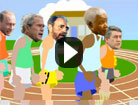“A leader is the one who climbs the tallest tree, surveys the entire situation, and yells ‘wrong jungle’. “ – Stephen Covey
“Leadership is something that can be learned by anyone, taught to everyone, denied to no-one.” – Warren Bennis & Burt Nanus
All those Churchillian and strutting male CEO images we associate with leadership can mean we don’t listen when someone who doesn’t fit the ‘leader’ mould is saying something extremely powerful.
Here’s an example: a 10-year-old girl who became a leader in a particular situation – a true story that helps break those strong prejudices in our heads about what a leader is. I’m toying with using this as the introduction to the leadership book I’m writing at the moment.
The girl, Tilly, was on the beach in Phuket, Thailand, with her family in December 2004. She noticed the sea looked odd. It was foaming, like the head of a beer, all across the sea. ‘Bad sea day’, she and her mum joked together. ‘Then I suddenly had a vision in my head of the video we watched in a geography lesson of the sea in Hawaii before a tsunami. It was exactly the same,’ Tilly said later.
At first her mum didn’t get it when Tilly told her, as if in a scene from the film Jaws, that they had to get everyone out of the water. So certain was Tilly of her recollection and of what was about to happen, that she became hysterical. Instead of telling her off, her parents listened, agreed to get the rest of the family off the beach, then persuaded the lifeguards to start getting people out of the sea.
They warned as many people as possible and then turned and ran when it became obvious Tilly was right about what was coming. Listening to a 10-year-old girl with a powerful story to tell saved their lives and the lives of many others.
So, the one who climbs the tallest tree and sees the bigger picture, as Covey puts it in the quote above, doesn’t have to be the person who heads the organization. Sometimes people at the front line, maybe in a relatively junior position, have a clearer view of where the organization is going wrong and, in this case, of a disaster that is about to strike.
What allowed Tilly to become a leader in this situation was a combination of her learning, her confidence in her own judgement, her urgent sense that she could and should make a difference, her concern and sense of responsibility for other people, and the readiness of her family to listen to her, trust her and ultimately be led by her. Does your organization (and that includes you) create that same set of circumstances (culture) to allow people at all levels to step up and take the lead when they need to?
I was talking to Elizabeth Handy, wife of Charles Handy, on the phone recently (name dropper? Moi?) when she reminded me of a point in their book The New Alchemists, about people who achieve great things:
“If you are going to do something great, you need one thing first – someone who told you when you were a child, and believed it, that you were capable of great things.”
It’s true, of course. And it applies to adults, too. We are all capable of great things. As long as we follow the lead of assertive, bright, feisty 10-year-olds who do the right thing rather than just do what they’re told.
PS Tilly is real, by the way, not an internet myth. She was awarded a bravery medal by the UK’s Marine Society.









Leave a Reply